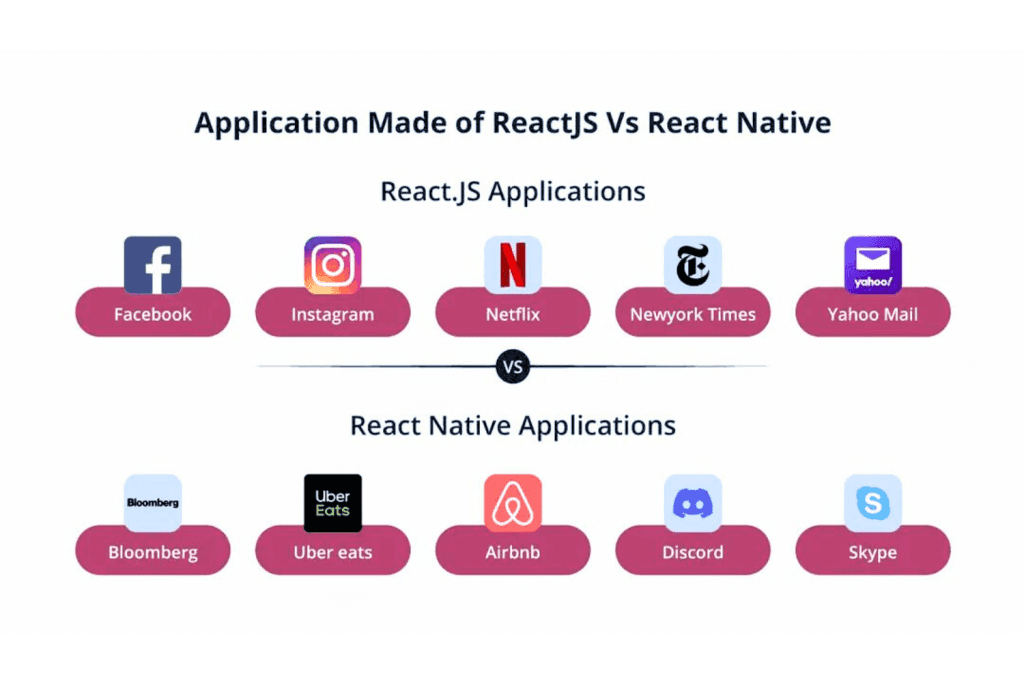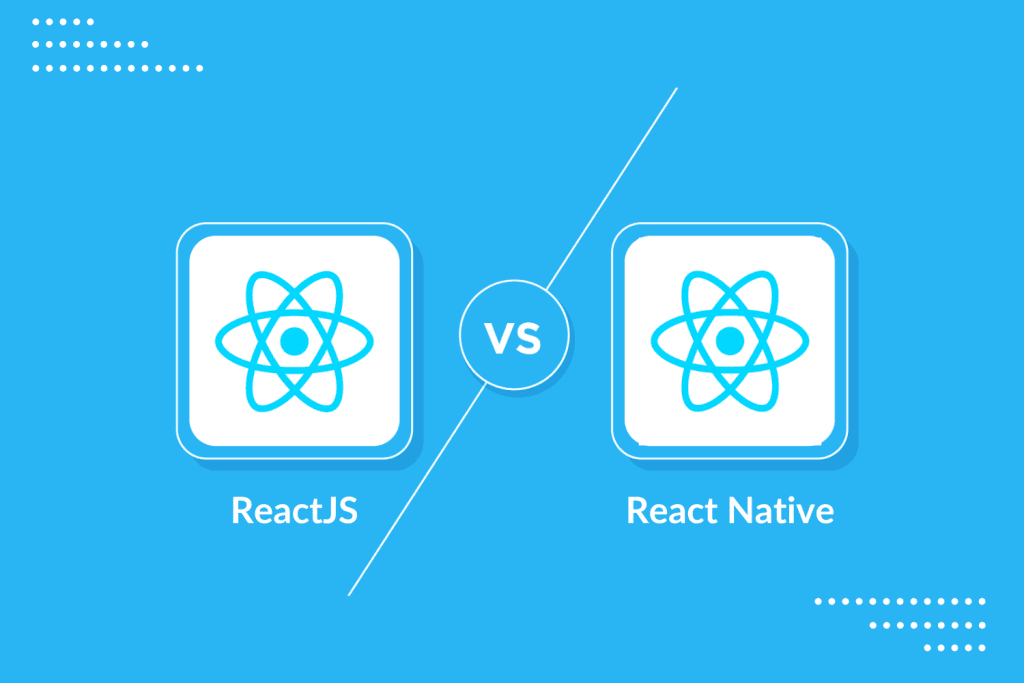ReactJS Web development is a crucial concept for the 21st century. Every business, product developer, support provider, and marketer requires a website or web application to interact with customers and share their brand, product, or service with the world. With such high significance, you must know the top formations of the day and how they compare.
JavaScript has been an integral part of web development since its inception. The React and React Native frameworks are among the top JavaScript frameworks that have created several trends, job opportunities, and aesthetically pleasing websites.
Understanding the differences between ReactJS and React Native is essential.
What is ReactJS?
Facebook designed React JS is a JavaScript library for building user interfaces that are both efficient and easy to maintain. It enables developers to create reusable native UI components and manage the state of their applications seamlessly.
ReactJS follows a declarative programming paradigm, allowing developers to describe the desired outcome of their UIs, and React takes care of updating the DOM to match that state.
Key Concepts
1. Components
Developers use components to build React applications, creating self-contained, reusable pieces of code that render specific parts of the user interface. Additionally, They can nest components within each other to create a modular and organized structure for the application.
2. JSX (JavaScript XML)
React uses JSX, a syntax extension that allows you to write HTML elements and components in a JavaScript file. Additionally, this makes it easy to visualize and understand the structure of your UI directly in your code.
3. Virtual DOM
One of the key reasons for React’s efficiency is its use of a Virtual DOM. Instead of updating the entire DOM when changes occur, React first updates a virtual representation of the DOM. It then compares this virtual DOM with the actual DOM and only makes the necessary updates. This process minimizes the number of manipulations on the real DOM, leading to better performance.
4. State and Props
React components can have a state, which represents the data that can change over time. Developers use props, short for properties, to pass data from a parent component to a child component. By managing state and props effectively, React enables the creation of dynamic and interactive user interfaces.
Why ReactJS?
- Declarative Syntax: Developers can describe what they want their UI to look like, and React takes care of updating the DOM to match that description.
- Component-Based Architecture: The modular structure of React applications makes it easy to maintain and scale projects.
- Reusability: Developers can reuse components across different parts of an application or even in multiple projects, promoting code efficiency.
- Community and Ecosystem: React has a vast and active community, contributing to a rich ecosystem of libraries and tools that enhance development.
What is React Native?
Facebook developed React Native as an open-source framework, enabling developers to build mobile applications using JavaScript and React. Launched in 2015, React Native quickly gained traction in the development community due to its ability to create cross-platform applications with a single codebase. This means developers can write code once and run it on both iOS and Android platforms, saving time and effort.
Key Features of React Native:
1. Cross-Platform Compatibility:
One of the most significant advantages of React Native is its cross-platform compatibility. Developers can use a single codebase to create apps that run smoothly on both iOS and Android devices. This eliminates the need to maintain separate codebases for each platform, streamlining the development process.
2. Reusability of Code:
React Native allows developers to reuse code components across different parts of their application or even in entirely different projects. This modular approach not only saves time but also ensures consistency and reduces the likelihood of bugs.
3. Hot Reloading:
The hot reloading feature in React Native enables developers to see the immediate results of code changes without restarting the entire application. This significantly speeds up the development process, making it easier to understand and experiment with different ideas and iterate quickly.
4. Native Performance:
Unlike other cross-platform frameworks that rely heavily on web views, React Native uses native components, resulting in better performance and a more authentic user experience.
5. Large and Active Community:
React Native benefits from a large and active community of developers. This means a wealth of resources, documentation, and third-party libraries are available, making it easier for developers to find solutions to common problems and stay updated on best practices.

Difference Between React JS vs React Native
| Comparison Factor | React.js | React Native |
| Purpose and Platform | ReactJS, commonly known as React, is a JavaScript library for building user interfaces for web apps. It is primarily used for creating dynamic and interactive UIs on websites. | React Native, on the other hand, is a framework for building cross-platform mobile applications. It allows developers to use React and JavaScript to create native mobile apps for iOS and Android platforms. |
| Rendering | ReactJS renders components on the web browser using the Virtual DOM (Document Object Model). It efficiently updates and renders only the components that have changed, leading to improved performance. | React Native renders components using native APIs for iOS and Android. This enables the creation of truly native user interfaces, providing a seamless user experience. |
| Components | Components in ReactJS are designed to work with web environments. They include HTML elements and are structured using JSX (JavaScript XML) syntax. | Components in React Native are specifically tailored for mobile development. They are composed of native UI elements, such as <View>, <Text>, and <Image>, which map directly to their native counterparts on iOS and Android. |
ReactJS and React Native
| Comparison Factor | React.js | React Native |
| Styling | Styling in ReactJS is typically done using CSS (Cascading Style Sheets) and stylesheets. It follows standard web styling practices. | React Native uses a combination of JavaScript and a subset of CSS for styling. Styles are applied using JavaScript objects, and platform-specific styling can be implemented easily. |
| APIs and Access to Device Features | ReactJS is focused on web development and does not have direct access to device features like the camera, GPS, or contacts. | React Native provides APIs and modules that allow direct access to device features, enabling developers to build mobile applications with native capabilities. |
| Deployment | Web applications built with ReactJS are deployed on web servers and accessed through browsers. | React Native apps are packaged as native binaries, making them available for download and installation from app stores (e.g., Apple App Store, Google Play Store). |

React JS vs React Native
The choice between React JS vs React Native depends on the specific requirements of your project. If you’re building a web application, ReactJS is the way to go. Its component-based architecture and virtual DOM make it an excellent choice for creating interactive and responsive user interfaces.
On the other hand, if your goal is to develop a mobile application that needs to run on both iOS and Android, React Native is the preferred option. With its cross-platform capabilities and native performance, React Native streamlines mobile app development and allows for code reuse across platforms.
Also read | 10 Useful JavaScript Coding Techniques That You Should Use
In summary, ReactJS and React Native are two sides of the same React coin, each tailored to meet the demands of different platforms. ReactJS excels in web development, offering a robust and efficient way to build interactive user interfaces.
React Native, on the other hand, extends the power of React to mobile development, providing a cross-platform solution with native performance. Understanding the strengths and use cases of each technology will guide developers in choosing the right tool for their specific project requirements.

